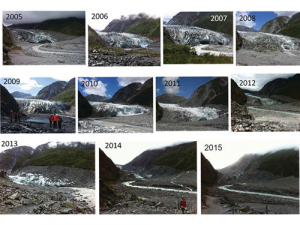But according to Paul Petrie, Principal Research Scientist at the Australian Wine Research Institute, we are in a far more fortunate situation than our neighbours Australia.
“Australian wine regions are starting from a lot warmer temperatures and if emissions continue at current rates, they are likely to get warmer still.”
Already wine regions in Australia are beginning to feel the impact of higher temperatures. Petrie said data collected as part of commercial maturity assessments across a range of Australian regions shows that since the early 90s until today the fruit has been ripening substantially earlier.
As an example, using Chardonnay from McLaren Vale, the data shows that in the early 90s the fruit reached a benchmark of 21.6 brix in mid to late March.
“As we tracked this over time, the fruit was ripening earlier and earlier, so in recent vintages, the Chardonnay is ripening in late January or early February. That is an average advancement of about 1.3 days every year.”
Cabernet Sauvignon which used to ripen in late March back in the 90s is now ripening in late January to early February – “almost two days earlier per year”.
That can cause problems for some winemakers, with vintage now a lot faster, busier and more compressed.
“Some wineries are struggling to manage all this fruit coming in at once,” Petrie said. “We have gone through a range of 21 days between the two varieties ripening in the early 90s down to seven days now.”
What impact does this have on the fruit quality? Well if the winery can’t process all the fruit at once, then they make a choice to take what they can in, and delay taking the rest. That is not ideal, Petrie said, given the fruit left can quickly rise by two or three brix, and the average berry weight can drop – about 10 percent - which could equate to a yield loss of 10 percent in just one week.
There are options though, one being to delay the maturity of some blocks.
“That would help spread our harvest out, improve our harvest logistics and would also move maturity back to a more normal time.”
A number of research projects in Australia are looking at just how growers can achieve that delay.
One option is to delay pruning – waiting until post budburst when the shoots at the end of the unpruned canes are 5-7 cm long.
“You then set the vine back by a couple of weeks and delay maturity. Importantly, the difference in phenology doesn’t close up over time, the maturity delay lasts through until harvest.”
There was also no detrimental impact on yields, when this scenario was carried out over a number of years, and winemakers involved were positive about fruit and wine quality.
Another technique that has been trialled involves spraying Shiraz vines with a plant growth regulator, an auxin (NAA).
“By spraying this just before veraison fruit maturity can be delayed by about 20 days. Once again, the winemakers were positive about the fruit quality from the trial.”
But this spray has yet to be registered, so is not an option yet for commercial growers.
Defoliation or removing leaves can also be used to delay maturity, but it has to be severe defoliation to have a significant effect. It also exposes the fruit far more and researchers are concerned about possible impacts on yields. Winemakers were also not as happy about the informal wines made from these trial blocks.
Even a small increase in average temperatures can also mean that extreme conditions become far more frequent. The occurrence of very hot conditions in Australia has grown exponentially from approximately 2% of the time during the 1950’s to 10% of the time between 1999 and 2013. If not dealt with, heatwaves can cause significant damage to vines and fruit, depending on the time of year.
“Vines are more sensitive at certain stages of development,” Petrie said. “At flowering they are more sensitive as high temperatures can impact on fruit set and yield, and they are very sensitive post veraison.”
This is when browning or sunburn occurs, and there is the higher chance of chemical damage.
“You may not necessarily see physical symptoms, but one chemical change is the reduced colour in red varieties. Fruit on the side of the row that was exposed in the afternoon sun, when temperatures were also warmer, had a lot less anthocyanins and a lot less tannin than fruit that received sunlight during the morning.”
(Based on research in California, looking at Cabernet Sauvignon.)
There are two management options available to growers here. One, reduce bunch exposure and/or increase cooling.
To increase cooling, the vines need to be well watered in advance of a predicted heatwave.
“It is important to turn those taps on when you have a forecast of a heat event, and start running five or six days in the lead up. Keep putting water on during the heatwave – and the canopy will manage a whole lot better.”
In terms of reducing bunch exposure – the easiest and cheapest way is to grow more canopy or change the way the canopy is laid out.
“In a lot of our cooler regions where we would have traditionally had a VSP system, a lot of our growers are going to a sprawling system or they are managing the VSP canopy to provide the fruit with more protection.”
For example, Petrie said, you can raise or lower the wires in different parts of the canopy.
Some growers put all the wires up at the start of the season, and if a heatwave is predicted, they take some down and let the canopy sprawl out to shade the fruit.
You could also lift the wire on the shady side of the canopy so the fruit has more exposure, while leaving the wire down or hooking it to a lower point on the side of the canopy that receives the afternoon sun.
“If you are going to take leaves off, you don’t necessarily have to take them off both sides of the vine – sometimes it is better to take them off the shaded side, not the exposed side.”
And remember that bare soil radiates more heat up into the canopy. Permanent swards, if you have enough water to feed them, will reduce the amount of damage to the fruit during heatwaves.
Long-term though, if temperatures and heatwave occurrences are going to continue to rise, it may be you have to consider a change in varieties, clones or row orientation.












